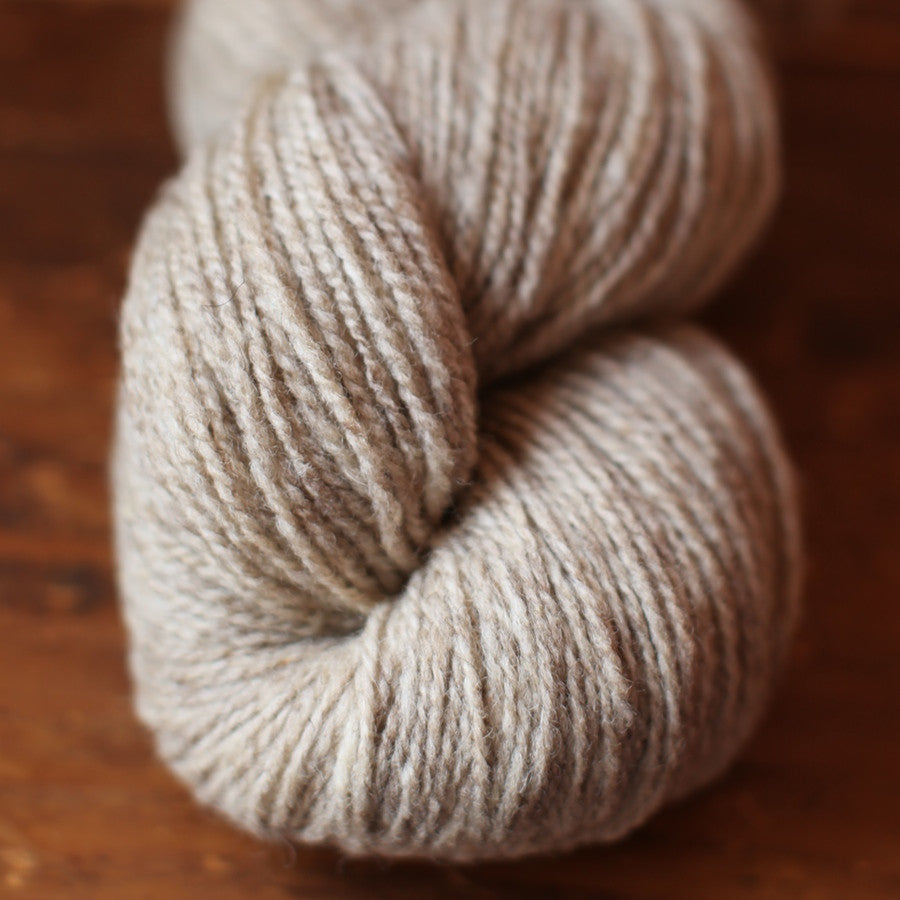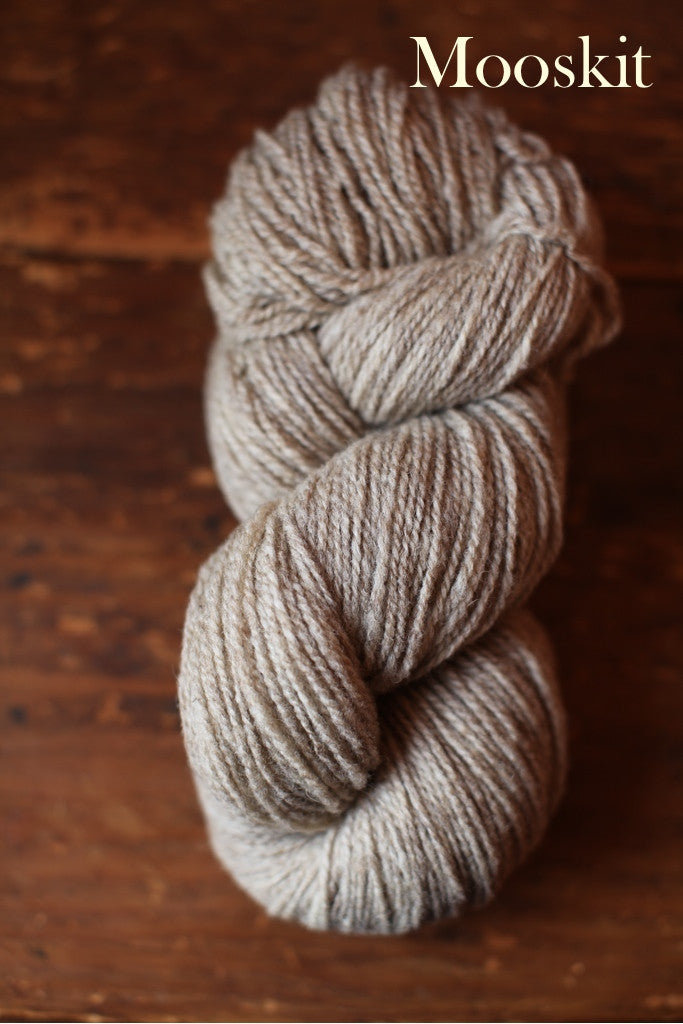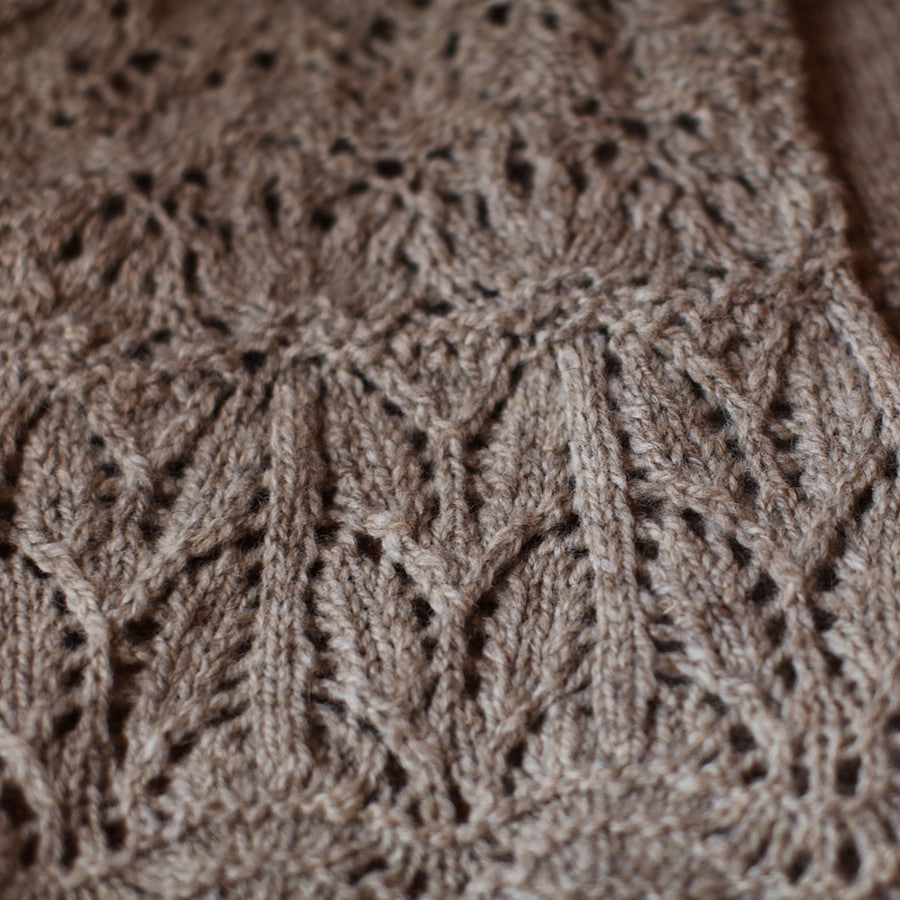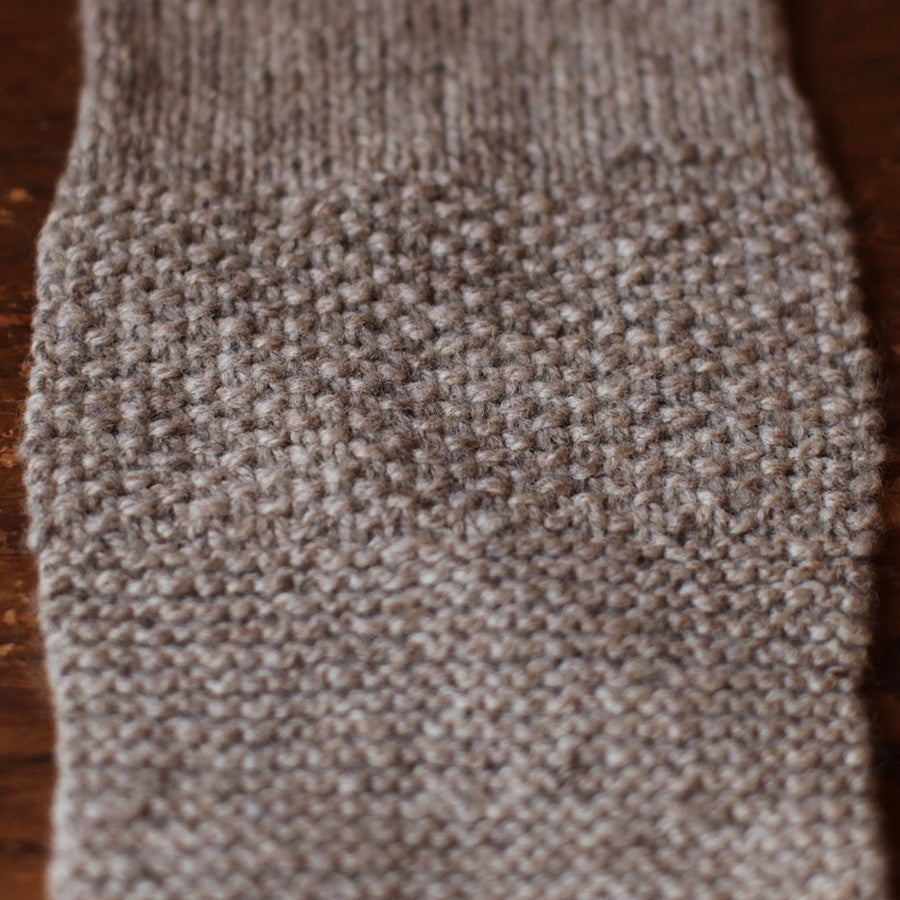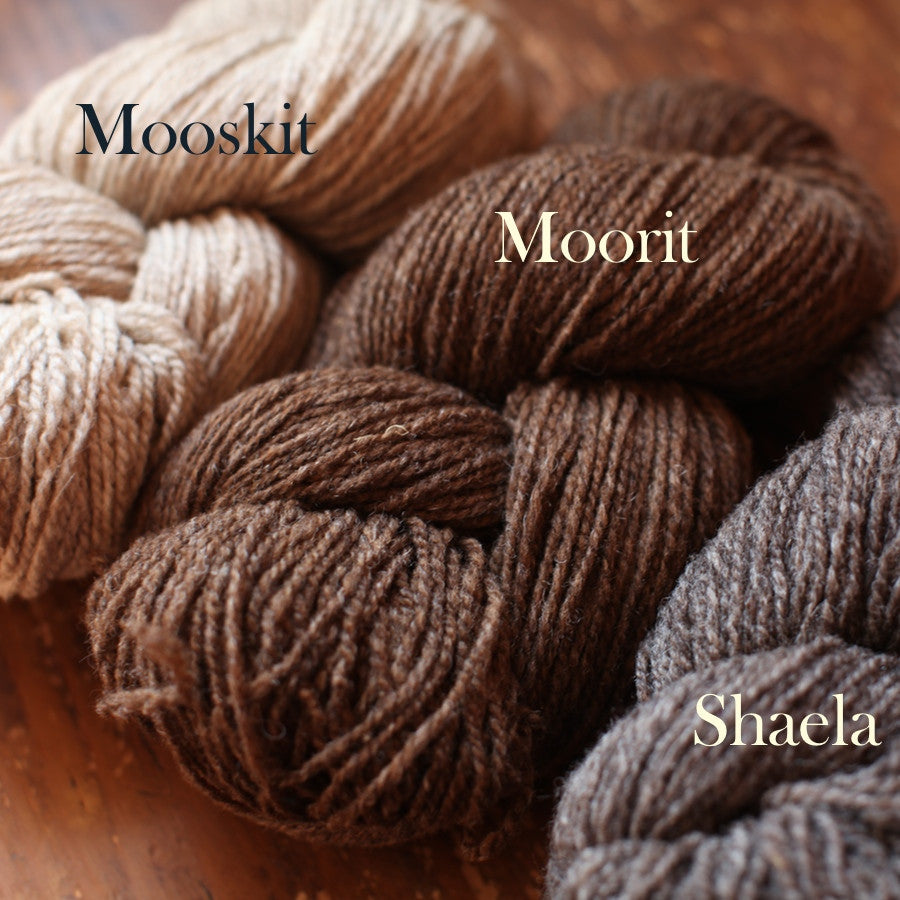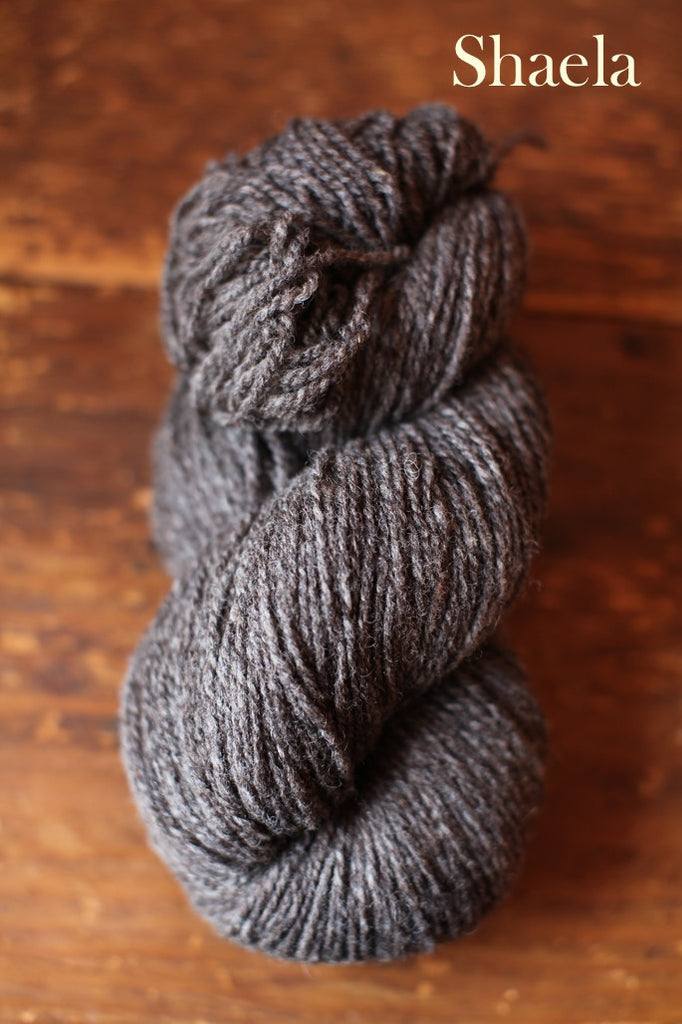Shetland 1.0
$ 28.00
Quick Facts
Gauge: A lofty woolen-spun two-ply yarn, Shetland 1.0 produces lovely fabric in a range of needle sizes and gauges between worsted, DK, and sport, making swatching essential. Look for 5 to 6 sts per inch on US 4-7 (3.5-4.5mm) needles.
Put-up: 300 yards (274m)
Skein weight: 92g (Actual weight varies between 92g and 99g)
Source: Wool from Shetland sheep raised on the Mendip Hills of Somerset, England. Fleeces were sorted by color and scoured at The Natural Fibre Company in Devon. Kindly stored at the Saco River Dyehouse in Biddeford, Maine. Fleeces blended into final colors; fibers picked, carded, spun, skeined, washed, and twisted at the historic Harrisville Designs mill in Harrisville, New Hampshire. Each skein was tagged and shipped to you from the Pepperell Mill Campus in Biddeford, Maine.
-
"If a sweater could talk, and tell you from its secret heart what it dreams of being made of - it would tell you this yarn. From the daydreaming stage (the colors are the best our woolly friends have to offer) to the knitting stage (it runs smoothly through the hands, and looks great in every stitch pattern I tried) to the wearing stage (it's cozy, soft, and looks to be amazingly durable), Shetland 1.0 is everything you and your sweater wants." - Amy Herzog
In the beginning...
This yarn began on the backs of Shetland sheep grazing the Mendip Hills of Somerset in southwestern England. They came from a single family and a single farm, that of shepherds Andrew (a champion hand-blade shearer) and his wife Jen.
I learned about this special flock from Sue Blacker, who operates The Natural Fibre Company in nearby Devon. Her mill has capacity to scour large quantities of raw fiber and spin both worsted and woolen yarns in less-than-industrial quantities, making it a preferred choice for those raising or wanting to spin breed-specific wools in the UK. I'd fallen in love with her yarns at the first Knit Nation in 2010, and we began talking possible collaborations soon thereafter.
I was particularly smitten with her Shetland yarn, which had a perfectly nuanced blend of natural color and lively texture, crunch and velvety softness. It's nearly impossible to obtain large quantities of Shetland fiber from the Shetlands themselves, where most farms sell their clip directly to the legendary mill Jamieson and Smith. But here, she managed to preserve the integrity of one farm, one flock alone.
In the fall of 2012, we began talks in earnest. Clara Yarn didn't even exist then, I just knew I wanted to make yarn out of these fibers. By April of 2013, just four months into my Great White Bale adventure, I had committed to the entire clip from Andrew and Jen's farm. Here's where I needed to put on the brakes. Suddenly I was responsible for the fate of not only a 676-pound bale of Saxon Merino, and two bales of scoured Cormo fiber, now I had nearly 2,000 pounds of Shetland wool with my name on it -- and in the UK, no less.
The original plan was for me to travel to England and work with Sue to spin several incarnations of the Shetland. Sue had scoured the fleece by now, sorting it into eight distinctly Shetland colors. She was ready to spin. If I came right then, I might even catch the tail end of lambing season.
It would have been beautiful. But at that moment, it was too much. I had a Great White Bale to shepherd, and a book to finish.
Bring on the bales
Sue agreed to ship me the fibers for safekeeping. I'd store them here in the US until I had more time and clarity about how best to work with these fibers. By November of 2013, heaps of paperwork complete, three tightly bundled bales of Shetland wool were loaded on a ship bound for New York. They made landfall over Christmas and sat in Kearny, New Jersey, accruing hefty storage fees while I learned the ropes of international shipping and customs brokers. Here I was rescued yet again by Claudia Raessler at the Saco River Dyehouse, who not only knew what a customs broker was, she knew one who could help.
By mid-January 2014, our three bales of Shetland wool finally arrived in Biddeford. Like old-fashioned steamer trunks, they showed nicks and scrapes from their journey. I could see exactly where Sue and her team had bundled each color into separate bags and then masterfully compressed them into marshmallow-like bales. One of the bundles had torn open, revealing a small tuft of black wool. I pulled it free and held the fibers in my hand, feeling both exhilarated and terrified. It's one thing to have a few hundred skeins of yarn in your stash, quite another to have 1,200 pounds of it.

A trip to Yarnlandia
Here, we turn our attention to the tiny mill town of Harrisville, New Hampshire, where yarn has been spun almost continually since 1794. In the 1800s, the original Harris family sold operations to the Colony family, which renamed it Cheshire Mills. Harrisville remained a mill town, almost in its entirety, until 1970 when Cheshire Mills finally closed.
It would have been easy for things to fall apart at this point, for the town to be sold off to developers brick by brick as has happened in countless other New England towns. But the Colony family had a hidden card in its pocket: a bright young son named John Colony. After studying English Literature at Harvard, he went on to study at Columbia School of Business. Unlike many others in his class, however, he wasn't interested in donning a suit and going to work in a tall building. He wanted to return to Harrisville and save his family's legacy. Even his father thought he was crazy.
But John (or Chick as he likes to be called) persisted. He immediately built a coalition that established the nonprofit Historic Harrisville in 1970. One by one, they bought up key buildings in the town, preserving them and leasing them back to businesses. It was never their goal to make Harrisville a museum, they wanted to keep this a living industrial town where people lived and worked. Toward that end, he founded Harrisville Designs to spin yarns for the handknitting and weaving markets, as well as manufacture floor and "friendly" looms for adults and children.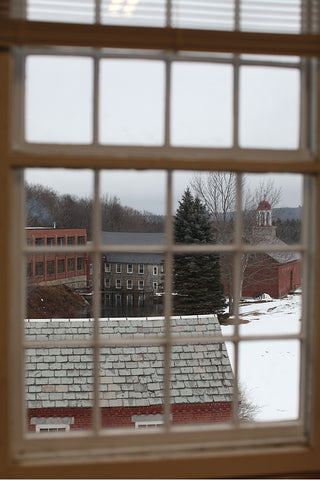
I have long dreamed of working with Harrisville, but word on the streets was that this was a tough nut to crack. What excess capacity they had was dedicated to spinning the exquisite Brooklyn Tweed yarns. Aware that there may be toes involved, I began by asking Jared for his blessings--which he gave with both pleasure and embarrassment that I would even feel the need to ask.
Next, I contacted Chick. To my amazement, he responded right away. It was June. They were pretty busy, he said, but they might have an opening in their schedule right before Christmas. But first, he would need to see samples of the fiber to be sure they could spin it.
I knew they could, but I needed to convince him. I tore that hole in the bale open and pulled out more fibers until I had a good sample, tucking them in a pouch and sending them on. Soon afterwards, Chick called and confirmed: These fibers were perfect for his equipment. Woolen spinning works best with high-crimp fibers whose staple length falls around three inches. Too long and the fibers won't draft properly; too short, and they'll snap. "We could do a nice job with this," I believe those were his exact words.
With Claudia's help yet again, the three bales were retrieved by a big truck and driven to Harrisville. And true to his word, in early December I got a call from Chick. They were finally ready to open the bales and begin sorting colors.
Color was the other reason I wanted these fibers to go to Harrisville. If you've ever seen any Harrisville Yarns, or Brooklyn Tweed for that matter, you'll already appreciate their exquisite ability to blend colors prior to spinning in order to produce a perfectly heathered yarn. Part of the magic of Shetland wool is its natural color nuance that runs from bright white through multiple shades of tans and greys, browns, and even black. The wrong mill could easily blend those initial eight colors into one mediocre beige.
Woolen spinning requires more fiber to get started--30 pounds has to be sacrificed before you have workable fiber. We didn't have enough fiber in each of those eight batches to make eight distinct yarns worth it, so we decided to pare it down to four colors: light tan, dark brown, light grey, and dark grey.
I grabbed my camera, gassed up my car, and sped across Maine into New Hampshire. It was just before Christmas now. Each town I passed grew smaller and prettier, with wreaths and bows and lights in every window. The final narrow two-lane road wound its way into Harrisville, reaching the red-brick village at the same time as the smell of woodsmoke hit my nostrils.
They were having their company Christmas party. "Take a plate! Help yourself!" said Pat, who is Chick's wife and equal at Harrisville. People made room for me at the end of the table. They wore santa hats were in high spirits. Soon, two golden retrievers joined us--the older one (Cyrus) belonging to Chick and Pat, the younger puppy (Stella) belonging to their son Nick.

Just as Chick had carried the family tradition, so their son Nick appears to be ready to accept the title of Crown Prince of Yarnlandia. After working in the Boston area, he chose to return to Harrisville and work for the family. A knitter himself, he developed 20 heathered colors for his own line, Watershed Wool. Part of the family's responsibility extends to managing the river that runs through town (the same river that powered the mill for almost 200 years)--which means constantly watching the weather reports and being ready to raise or lower the dams as needed to keep their town, or others up and downstream, from flooding.
Harrisville offices are in an old mill building in the center of town. The looms are also made here and shipped around the world. Chick gave me a tour, and it looked for all the world like Santa's workshop.
We stepped outside just as it began to snow, getting into Chick's car and driving down the road to the mill building. It's one of the "newest" buildings in town, having been built in 1977 in the old freight yard.
Most mills I visit tend to hinge on one person. And here, as much as I'd like to say that person is Chick, it's really a woman named Babs. The mill crew is her responsibility. Perfecting the heathered color formulas, that's what she does. She didn't want to be in a picture and waved away any praise, but Chick assured me (and I believed him) that she was the smartest person he'd ever met.
They had already finished blending and spinning singles of the light brown (called Mooskit). It was on cones, some had been steamed already to set the twist, and next it would be plied, skeined, twisted into finished skeins, and boxed up for us.

Up next, the dark brown fibers (Moorit) were being blended and carded. Each final color was really the result of blending other natural colors together. Because we're talking natural colors, and not evenly dyed ones, the capacity for variation and nuance was both exquisite and challenging.
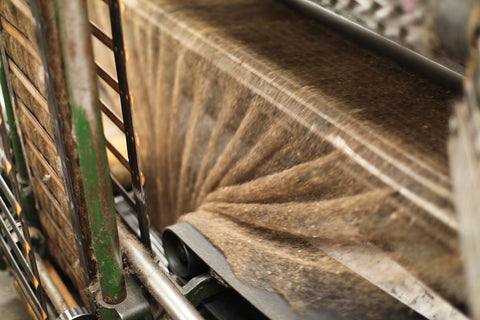
You can tell right away if the fiber is posing problems on the cards. People are walking to and fro, scowling and tinkering. Brows are furrowed. You feel guilty, since the fibers are yours. The truth of woolen spinning is that you make yarn on the cards. If the fibers pose problems there, if they clump or don't hold together, you'll be plagued with problems when you try to spin.
But today, on this magical pre-Christmas day, the yarn gods were with us. These beautiful Shetland fibers that had traveled so far and waited so long, they were positively purring on the equipment. On the cards, they flowed smoothly and evenly. The spinning frame hummed contentedly, not once needing to be stopped because of a break. "It's so strong!" was the common exclamation. It was the kind of experience that renews your faith in pretty much everything, human and fiber alike.
Several weeks later, a semi truck backed into the loading dock at the Saco River Dyehouse and unloaded mountains of boxes that had been secured on pallets. I like to imagine they stood briefly in the same spot as the bales had, so many months ago.
But this time, they stayed there only briefly before being moved to the Quince & Co. warehouse, where Adi and her team began the task of labeling each and every skein.
The initial release features three colors, a light brown called Mooskit, a dark brown called Moorit, and a dark grey called Shaela (think "shale"). These are traditional Shetland color names. Just to be sure I didn't make a rookie mistake, I brought a skein of each color with me to Edinburgh, and they were matched to the Jamieson's & Smith colors.
If you've been paying attention you may note I said we made four colors, whereas this release features only three. The fourth color, a light grey, was so close in proximity to Mooskit that I decided to set it aside for an overdyeing project in the future. Stay tuned!
-
The following was excerpted from Clara's book, The Knitter's Book of Wool: The Ultimate Guide to Understanding, Using, and Loving this Most Fabulous Fiber.
Like their Icelandic cousins, Shetland sheep most likely were deposited on the rocky, windswept islands between Scotland and Norway by Viking settlers more than 1,000 years ago. They are part of the Northern European Short-Tailed group of sheep, whose cousins include Finns and Icelandics.
Geographic isolation helped maintain the genetic purity of the breed until the Shetland woolen industry reached its peak, at which point the quest for more valuable bright white fiber caused breeders to eliminate many of the colored variants. Today, only 11 main colors and 30 markings remain, many of which still bear their original names like mioget, musket, moorit, blaegit, fleckit, and sholmit.
Shetland sheep have an alert and nimble disposition. Having accompanied humans since the Bronze Age, they are rather comfortable around people. But whereas their improved-breed counterparts have been bred to trust and follow sheepdogs, Shetland sheep instinctively consider sheepdogs predators and run away from them. Put a sheepdog in with a flock of Shetlands, and by the end of the day you’ll have one very depressed dog—and a flock of Shetlands on the opposite end of the field.
The quality and behavior of Shetland fiber can vary dramatically from region to region and flock to flock. One animal can grow as many as five different types of fiber, the suitability of which ranges from underwear to socks, sweaters, and rope. The finest wool comes from around the neck area and can make an extraordinarily fine, soft yarn—especially in lace weight. Those fibers were traditionally reserved for Shetland lace wedding ring shawls, enormous works of art that were so fine that they could pass through the inside of a wedding ring.
Shetland wool usually is spun woolen so that the short, crimpy fibers can spread out—or “bloom”—and make themselves at home. It produces a warm, cohesive, and well-wearing fabric. In colorwork, woolen-spun Shetland wool creates the beautiful, heathered effect for which the Fair Isle colorwork tradition is so well known. The fiber’s tendency to bloom is especially handy in concealing colors that are being carried along the back of the work. And as an added benefit, the fibers stay put so nicely that if you drop a stitch, it’ll stay right where you left it.
- This is a happy yarn. It's honest and sturdy, yet it's also tender and touchable. Shetland can sometimes feel dry and crackly, but this yarn--whether from the flock itself, the gentle scouring, or the equally gentle woolen spinning process--retains a succulence that's both rare and at the heart of what I think a good Shetland yarn can be. The short, finer fibers in the fleece give softness and bounce, while the longer fibers give the yarn surprising strength.
The yarn's easy disposition extends to gauge, where it willingly expands and contracts to fill whatever space your needles provide. It produces a gaspworthy garter stitch, a plump and huggable lace, mossy textured stitches, and a wonderfully cohesive stockinette. Colorwork is both beautiful and forgiving, with the yarn's bounce and bloom filling in any gaps. Shetland 1.0 begs for Maisie Dobbs, Foyle's War, or Poirot costuming. And when you drop the fabric in warm soapy water? The bloom is pure heaven.
I knew a few people who would enjoy this, so I sent samples to Jane Cochran, Bristol Ivy, and--because I think this is the ultimate sweater yarn--Amy Herzog. I gave no rules in terms of garment type of style. I just asked that they spend time with the yarn first, swatch until the yarn spoke to them, and design from there.

Stony Hill by Jane Cochran
Thornton by Bristol Ivy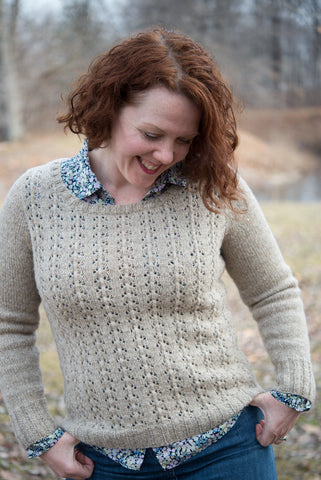

Hello did someone say Foyle's War? It seemed to me that Shetland 1.0 was the perfect yarn to run through Amy Herzog's Customfit, allowing you to create the very best garment for your body and your gauge with this yarn. After some playing, Amy Herzog was inspired to create the two-versioned Foyle's Sweater with a Foyle's Pullover version for her, a Foyle's Cardigan for me.
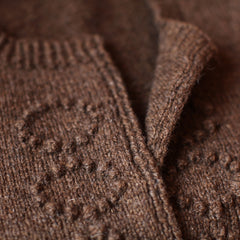
Speaking of cardigans, Shetland 1.0 is also the perfect yarn for Julia Farwell Clay's Tambourine Cardigan, which was featured on the cover of the Spring 2015 issue of PomPom Quarterly (issue 12).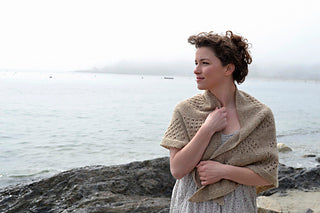
And finally, Beatrice Perron Dahlen nailed the wistful coziness of this yarn in her Bonnie Banks Shawl, which can be completed (with minor adjustments explained in the pattern) with just two skeins.
Now it's your turn!

